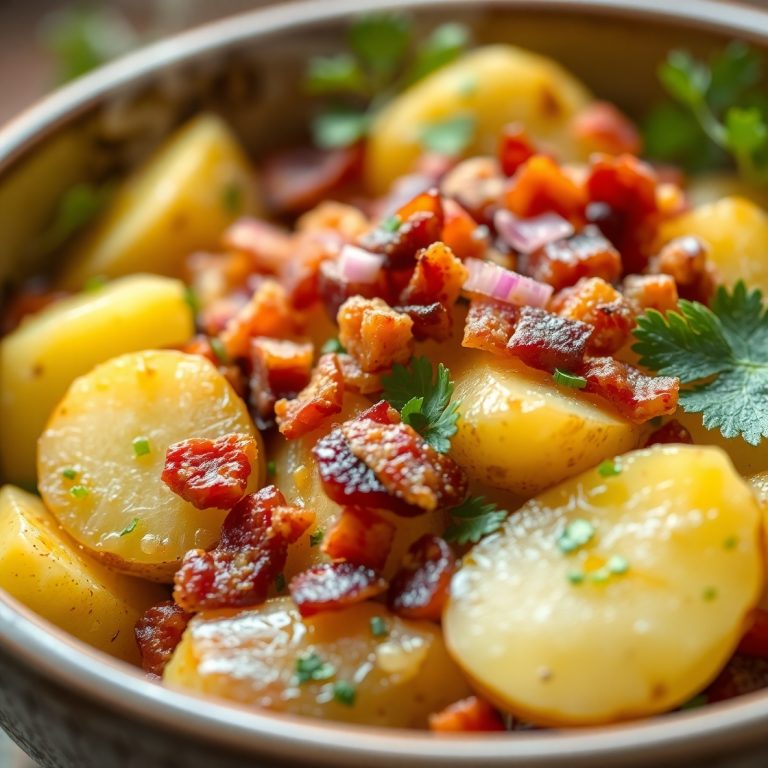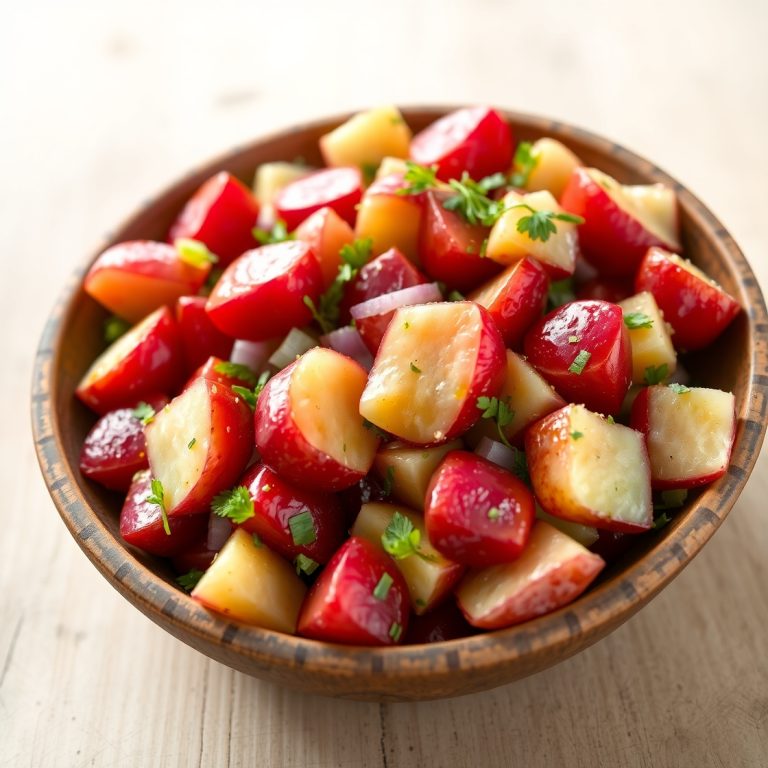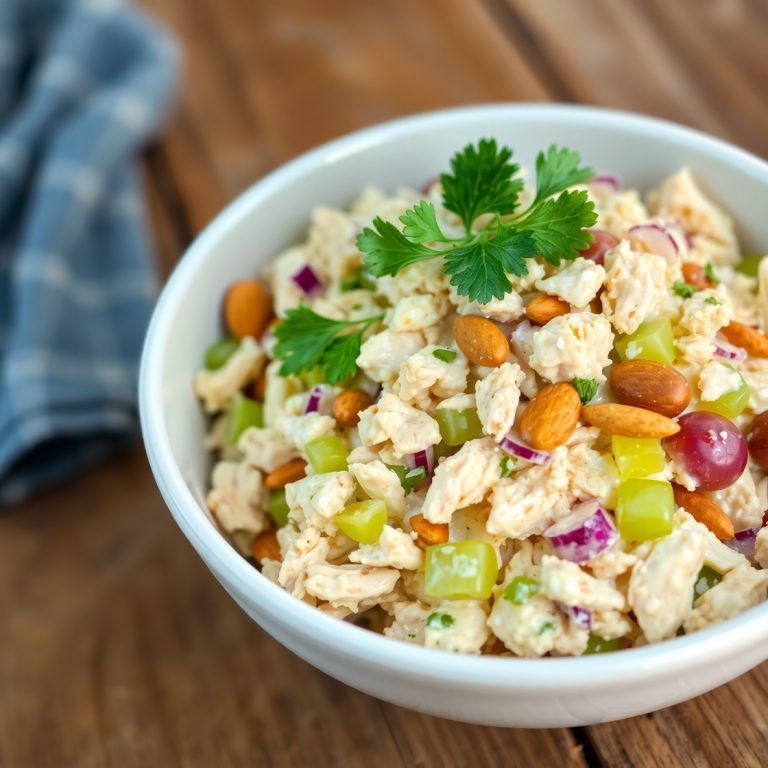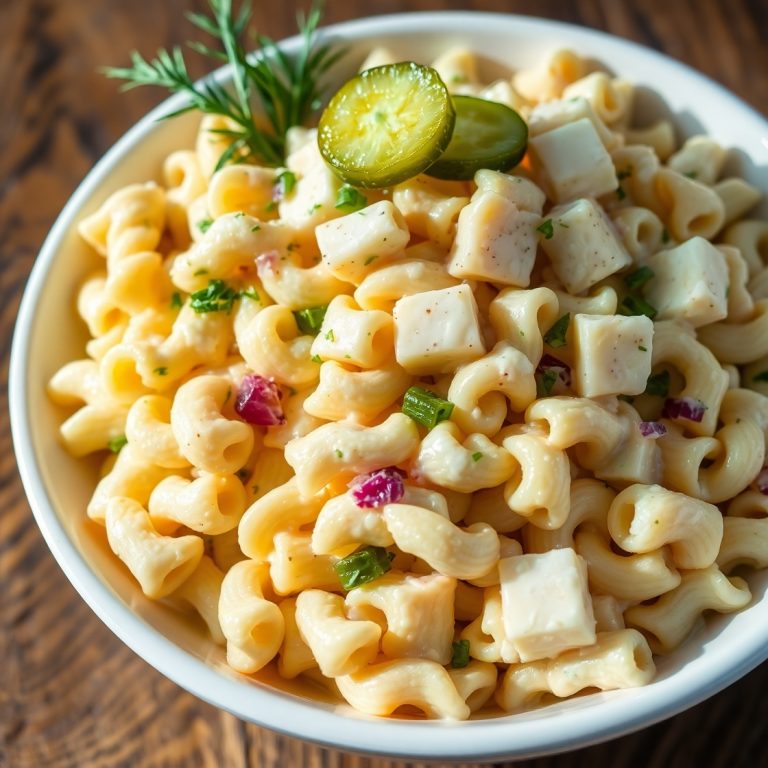
There’s something timeless and comforting about a bowl of crisp, fresh garden salad. It’s the kind of dish that feels equally at home on a summer picnic table as it does beside a weeknight roast chicken or a grilled steak. This recipe was born out of a need to bring simplicity back to the table—one that celebrates the honest, unpretentious flavors of seasonal vegetables without overcomplicating them.
Whether you’re aiming to lighten up your meal, need a go-to side dish, or are simply craving something crunchy and refreshing, this garden salad is for you. It’s not just a pile of vegetables; it’s the kind of salad that reminds you why fresh really does taste best.
Keep reading and I’ll show you how to turn everyday vegetables into something genuinely satisfying and downright irresistible.
Why I Love This Recipe

What makes this garden salad stand out isn’t just its ease or freshness—though those are definitely part of the appeal. It’s the way each component plays its part perfectly. The crunch of the cucumbers, the juicy sweetness of cherry tomatoes, the slightly peppery bite of red onions, and the crispness of romaine or iceberg lettuce all come together in a balanced, vibrant medley.
This salad is proof that simple doesn’t mean boring. With a homemade vinaigrette that’s tangy, slightly sweet, and just the right amount of sharp, this dish becomes a little celebration of good ingredients.
I also love how versatile it is. You can serve it on its own as a light lunch, pile it alongside grilled meats or fish, or even use it as a base for something more elaborate, like adding grilled chicken, feta, or chickpeas for a heartier meal.
Another reason I return to this recipe again and again is because it truly lets you cook with what you have. A garden salad adapts beautifully to the seasons—swap in radishes in spring, fresh corn in summer, or roasted beets in autumn. It’s endlessly flexible, which makes it a staple for anyone who wants to eat well without fuss.
Ingredients for Garden Salad
The key to a great garden salad lies in freshness. Use the best quality vegetables you can find—they don’t need to be fancy, but they should be crisp and vibrant.
Here’s what you’ll need:
Leafy Base:
You can use romaine lettuce for crunch, iceberg for that classic cool bite, or mixed greens like arugula, baby spinach, and leaf lettuce for a more tender texture. I often use a blend—it gives dimension and keeps each bite interesting.
Tomatoes:
Cherry or grape tomatoes are ideal because they’re sweet, bite-sized, and juicy. You can also use heirloom or Roma tomatoes, chopped into chunks.
Cucumbers:
Thin-skinned cucumbers like Persian or English cucumbers are best—they’re seedless, crisp, and don’t need peeling.
Carrots:
Julienned or thinly sliced carrots add sweetness and a firm bite. You can even use a vegetable peeler to create ribbons.
Red Onion:
Sliced very thinly, red onions bring a sharp edge to the salad. If you want a milder taste, soak the slices in cold water for 10 minutes before adding.
Bell Peppers:
Red, yellow, or orange bell peppers add color and a subtle sweetness that balances the sharper elements.
Radishes (optional):
For a little extra crunch and peppery zing, thin slices of radish are a great addition, especially in spring or early summer.
Fresh Herbs:
Flat-leaf parsley, dill, or basil add brightness. Use them sparingly but intentionally—they take the salad from good to memorable.
The Dressing:
A homemade vinaigrette ties it all together. I use extra virgin olive oil, red wine vinegar, Dijon mustard, a touch of honey, garlic, salt, and freshly cracked black pepper. It’s bold enough to flavor the vegetables without overpowering them.
How Much Time Will You Need?
This salad is all about ease and speed. It takes:
- 10 minutes for washing and prepping the vegetables
- 5 minutes to make the vinaigrette
- 5 minutes to toss and assemble everything
So you’re looking at 20 minutes total, start to finish. Perfect for busy weeknights, quick lunches, or when you need a side dish in a pinch.
How to Make This Garden Salad

Here’s a detailed, foolproof step-by-step guide to help you make the freshest, most flavorful garden salad.
Step 1: Wash and Dry Your Vegetables
Use a salad spinner if you have one. Clean, dry greens are essential—the vinaigrette won’t cling properly to wet leaves. Wash all vegetables thoroughly, especially lettuce, which tends to trap dirt.
Step 2: Chop the Vegetables
Chop lettuce into bite-sized pieces. Halve the cherry tomatoes. Slice cucumbers into thin rounds. Julienne the carrots or peel into ribbons. Slice the bell peppers and onions very thinly. If using radishes, slice them into paper-thin rounds. Chop your herbs finely.
Step 3: Make the Vinaigrette
In a small bowl or mason jar, combine:
- ⅓ cup extra virgin olive oil
- 3 tablespoons red wine vinegar
- 1 teaspoon Dijon mustard
- 1 teaspoon honey (or maple syrup)
- 1 minced garlic clove
- Pinch of salt and freshly ground black pepper
Whisk or shake well until emulsified.
Step 4: Assemble the Salad
In a large bowl, combine all the vegetables and herbs. Add just enough dressing to lightly coat everything, then toss gently with clean hands or salad tongs. Taste and adjust with more salt, pepper, or dressing as needed.
Step 5: Serve Immediately
Transfer to a serving bowl or platter. Sprinkle with a little extra parsley or cracked pepper for a finishing touch. Serve right away for best texture and flavor.
Substitutions
A great garden salad is adaptable. Here are some thoughtful substitutions you can make based on what’s in your kitchen:
- Lettuce: Swap romaine with spinach, kale (massaged), butter lettuce, or a mix of spring greens. Arugula adds a nice peppery kick.
- Cucumbers: If you don’t have fresh cucumbers, try thinly sliced zucchini for a similar texture.
- Tomatoes: Use chopped heirlooms or vine-ripened tomatoes when in season. Sun-dried tomatoes (reconstituted) can be a tangy alternative.
- Onion: Shallots can be used for a milder, sweeter onion flavor. Green onions also work well.
- Dressing: Balsamic vinegar can be used instead of red wine vinegar. Lemon juice adds brightness if you want a citrusy note. You can also add Greek yogurt to make a creamy dressing.
- Add-ins: Croutons, toasted nuts, seeds (like sunflower or pumpkin), or crumbled feta or goat cheese all make great mix-ins when you want to bulk up the salad.
Best Side Dishes for Garden Salad
While a garden salad shines on its own, it really comes alive when paired with something hearty or comforting. Here are three favorites:
1. Grilled Lemon Herb Chicken
Simple grilled chicken breast marinated in olive oil, garlic, lemon juice, and herbs. Light, juicy, and the perfect pairing.
2. Garlic Butter Shrimp Skewers
These cook up in just minutes and add protein and a little indulgence without overpowering the salad’s fresh taste.
3. Crusty Artisan Bread
A warm, crusty loaf of sourdough or country-style bread is always a welcome addition. Dip it in extra vinaigrette or use it to scoop up leftover veggies.
Serving and Presentation Tips

The beauty of a garden salad is how effortlessly elegant it can look with just a little attention to presentation. Here’s how to make your salad look as fresh and vibrant as it tastes:
Use a wide, shallow bowl or a platter: This prevents the greens from getting crushed and gives space for all the colorful ingredients to shine.
Layer the ingredients: Instead of tossing everything at once, try layering in components like tomatoes, cucumbers, and carrots after laying the greens. This keeps everything visually balanced and prevents heavier items from sinking to the bottom.
Garnish just before serving: A final sprinkle of freshly chopped herbs, a few twists of cracked pepper, and a light drizzle of dressing added at the last minute help the salad look polished and inviting.
If you’re serving it for guests, you can even add edible flowers like nasturtiums or pansies for a touch of charm. And always serve it with chilled plates—it helps keep everything crisp.
Tips and Tricks to Make This Recipe Even Better
Here’s the hook: A truly great garden salad isn’t just about throwing vegetables into a bowl—it’s about coaxing the best flavors and textures from simple ingredients. These tricks will take your salad from basic to unforgettable:
- Dry your greens thoroughly: Watered-down dressing is one of the most common salad mistakes. Use a salad spinner or pat leaves dry with a clean kitchen towel.
- Salt your tomatoes and cucumbers lightly: Let them sit for a few minutes to draw out their juices and concentrate their flavor. It also prevents them from watering down the salad later.
- Taste the dressing before adding it to the salad: Every vinegar, mustard, and olive oil brand is different. Adjust the salt, sweetness, or acidity to your liking before tossing.
- Toss gently and sparingly: Over-mixing bruises the greens and can make them soggy. Use just enough dressing to coat—don’t drown.
- Use seasonal ingredients: If it’s peak tomato season, let those shine. In colder months, try shredded cabbage, beets, or even roasted sweet potatoes as a base.
Common Mistakes to Avoid
Even with a simple salad, a few easy missteps can affect the outcome. Here are the most common ones and how to avoid them:
- Adding the dressing too early: Always dress the salad right before serving. Otherwise, the greens wilt and lose their crunch.
- Overloading with toppings: Keep balance in mind. Too many crunchy add-ins or cheese can overpower the delicate vegetables.
- Not seasoning enough: A pinch of salt and fresh pepper go a long way. Seasoning brings out the natural flavors of the vegetables.
- Using old or limp produce: A garden salad depends on freshness. Use crisp, vibrant ingredients for the best taste and texture.
- Skipping acidity: Acid is what brings life to your salad. Make sure your vinaigrette has enough vinegar or citrus to brighten the entire dish.
How to Store It
Garden salad is best eaten fresh, but if you need to make it ahead or save leftovers, here’s how to store it properly:
- Undressed salad: Store washed, chopped vegetables in a large airtight container lined with paper towels. The towels absorb excess moisture and keep everything crisp. It will last up to 2 days.
- Dressing: Keep the vinaigrette in a separate jar in the fridge. It will keep well for up to a week. Shake before using.
- Dressed salad: If you’ve already dressed the salad, you can store leftovers in the fridge for up to 12–18 hours. It won’t be as crisp but still makes a nice base for wraps or sandwiches the next day.
Tip: Never freeze garden salad—it turns mushy and loses all its texture.
FAQ
Q1: Can I make this salad ahead of time?
Yes—prepare and store the chopped vegetables and dressing separately. Combine and toss with dressing just before serving.
Q2: How do I keep the lettuce from getting soggy?
Dry it completely before storing or assembling the salad. Always dress just before serving.
Q3: Can I add protein to make this a full meal?
Absolutely. Grilled chicken, boiled eggs, tuna, tofu, or chickpeas make excellent protein-rich additions.
Q4: What’s the best vinegar for the dressing?
Red wine vinegar is classic, but apple cider vinegar or lemon juice also work beautifully depending on your flavor preference.
Q5: Can I use store-bought dressing?
Yes, though homemade vinaigrette is fresher and usually healthier. If using store-bought, choose one with minimal ingredients and no added sugar.

Garden Salad Recipe
- Total Time: 15minutes
- Yield: 4 servings
- Diet: Vegetarian
Description
A crisp and refreshing garden salad that celebrates fresh seasonal vegetables. This classic recipe is perfect as a side dish or a light, wholesome meal. Tossed in a zesty homemade vinaigrette, it’s the kind of salad you’ll want to come back to again and again. Whether you’re serving it at a summer cookout, alongside grilled meats, or enjoying it for lunch, it’s a clean, simple, and utterly satisfying dish.
Ingredients
6 cups mixed salad greens (romaine, arugula, or spring mix)
1 cup cherry tomatoes, halved
1 cup cucumber, thinly sliced
½ cup shredded carrots
¼ red onion, thinly sliced
½ bell pepper, thinly sliced
2 tablespoons chopped fresh parsley
Optional: 2 radishes, thinly sliced
For the Dressing:
⅓ cup extra virgin olive oil
3 tablespoons red wine vinegar
1 teaspoon Dijon mustard
1 teaspoon honey
1 garlic clove, minced
Salt and pepper to taste
Instructions
- Wash and thoroughly dry all vegetables, especially greens.
- Chop lettuce and slice all vegetables as directed.
- In a small bowl or jar, combine olive oil, vinegar, mustard, honey, garlic, salt, and pepper. Whisk or shake well.
- Combine all vegetables and herbs in a large bowl.
- Add dressing gradually and toss gently until coated.
- Serve immediately, garnished with extra herbs or freshly cracked black pepper.
Notes
-
Always dry your greens to help the dressing cling properly.
-
You can prep the vegetables a day in advance—just store them undressed.
-
Try variations like adding avocado, olives, or toasted nuts for extra flavor.
- Prep Time: 15 minutes
- Cook Time: 0 minutes
- Category: salad
- Method: Raw
- Cuisine: American
Nutrition
- Serving Size: 1.5 cups
- Calories: 160






